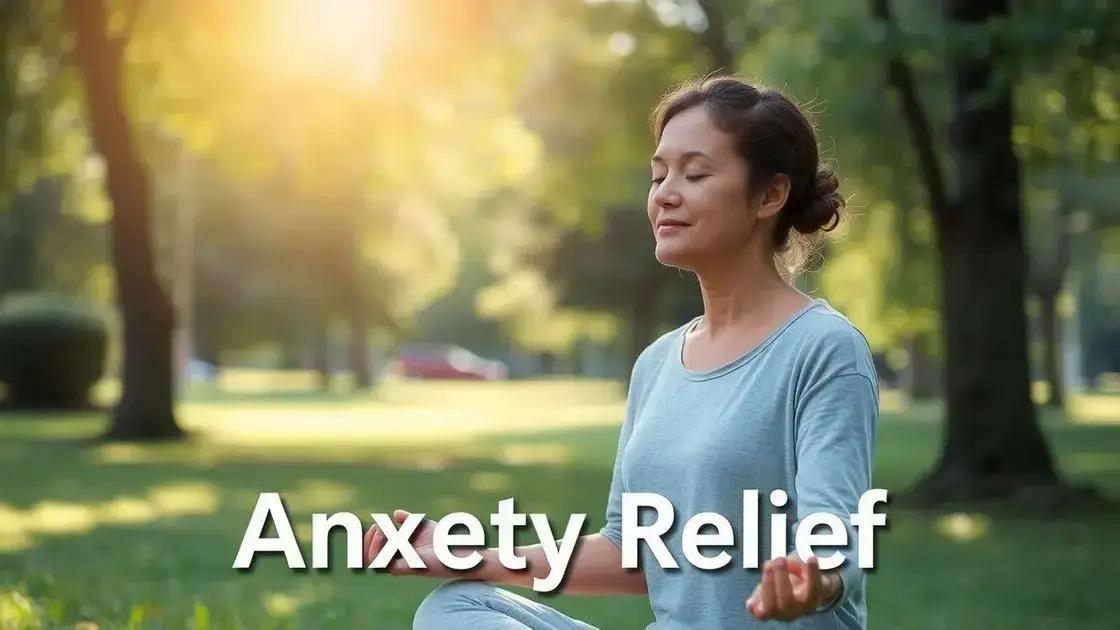Managing anxiety effectively involves techniques like controlled breathing, grounding exercises, and regular physical movement, which can significantly enhance mental well-being and reduce symptoms of stress.
If you’re struggling with anxiety, you’re not alone. Anxiety can be manageable, and discovering techniques to alleviate it can empower you.
Join Thousands of Women Rediscovering Their Energy
This gentle method gave me back the vitality I thought was gone forever
Understanding your body’s response to anxiety
Understanding how your body reacts to anxiety is crucial for managing it effectively. When faced with stress, it’s common for your body to undergo various physiological changes.
Physical Reactions
During anxious moments, you may experience a racing heart, sweating, or shallow breathing. These reactions are part of the body’s natural fight-or-flight response. Being aware of these symptoms can help you recognize anxiety when it arises.
The Brain’s Role
Your brain plays a significant role in processing anxiety. Neurotransmitters such as serotonin and dopamine impact how we feel. Understanding this can empower you to seek solutions and interventions.
Emotional Responses
Along with physical symptoms, anxiety often brings emotional reactions including fear, restlessness, or irritability. Learning to identify these emotions can be the first step towards effective management.
Mind-Body Connection
The connection between your mind and body is powerful. Exercises like mindfulness and meditation can help bridge this gap, allowing you to feel more in control when anxiety strikes.
Techniques for controlled breathing
Controlled breathing techniques can significantly help in managing anxiety. These methods can calm your mind and reduce physical symptoms of stress.
What is Controlled Breathing?
Controlled breathing involves consciously regulating your breath, allowing you to influence your body’s stress response. This technique can divert your attention from anxious thoughts.
Deep Breathing Exercise
One effective method is deep breathing. Inhale deeply through your nose for four counts, hold for four counts, and then exhale slowly through your mouth for six counts. Repeat this several times to feel a sense of calm.
Box Breathing Technique
Another option is box breathing, where you visualize a box as you breathe. Inhale for four counts, hold for four counts, exhale for four counts, and hold again for four counts. This rhythmic pattern can help stabilize your emotions.
Diaphragmatic Breathing
Diaphragmatic breathing focuses on engaging your diaphragm. Lie down or sit comfortably, place one hand on your chest and the other on your abdomen. Inhale deeply, ensuring your diaphragm inflates, and exhale slowly. This method encourages relaxation and reduces tension.
Using Breathing Apps
There are several mobile apps available that guide you through breathing exercises. These apps can provide visual and audio cues to help you maintain your focus while practicing controlled breathing.
Grounding exercises to stay present
Grounding exercises help you stay anchored in the present moment, which can be especially useful during times of anxiety. These techniques can pull your mind away from overwhelming thoughts and feelings.
What are Grounding Exercises?
Grounding exercises focus on reconnecting you to your body and surroundings. They help you feel safe and present, especially when you are feeling anxious or overwhelmed.
The 5-4-3-2-1 Technique
One popular grounding exercise is the 5-4-3-2-1 technique. Identify five things you can see, four things you can touch, three things you can hear, two things you can smell, and one thing you can taste. This process can help shift your focus from anxiety to your immediate environment.
Focus on Your Breathing
An effective grounding method is to concentrate on your breathing. Inhale slowly and feel your breath fill your lungs. Hold for a moment and then exhale gently. Notice how your body feels as you breathe in and out.
Physical Grounding Methods
You can also use physical activities for grounding, such as pushing your feet against the floor or holding onto a stable object like a chair. These actions create a connection to your environment, enhancing feelings of stability.
Mindfulness Meditation
Mindfulness meditation is another effective grounding technique. Sit quietly, focus on your breath, and observe your thoughts as they come and go without judgment. This practice encourages you to stay present and engaged with your surroundings.
The role of physical movement in anxiety management
Physical movement plays a significant role in managing anxiety. Engaging in regular exercise can help alleviate symptoms and improve your overall mental health.
How Exercise Affects the Brain
When you exercise, your brain releases endorphins, which are natural mood lifters. These chemicals help reduce feelings of stress and anxiety, making you feel happier and more relaxed.
Types of Physical Activities
Different types of physical activities can be effective for anxiety management. Activities such as walking, running, yoga, or dancing can provide both physical and mental benefits. Choose something you enjoy to make it easier to stick with.
Consistency is Key
To reap the benefits, it’s important to stay consistent with your exercise routine. Aim for at least 30 minutes of moderate exercise most days of the week. This can lead to long-term improvements in your mental well-being.
The Mind-Body Connection
Physical movement enhances the mind-body connection. Mindful practices like yoga and tai chi can help you focus on your breath and body, promoting relaxation and reducing anxiety symptoms.
Incorporating Movement into Daily Life
Incorporating more movement into your daily life doesn’t have to be complicated. Simple changes like taking the stairs, stretching during breaks, or going for short walks can make a big difference over time.
Managing Anxiety Through Simple Techniques
In conclusion, managing anxiety is achievable with the right techniques. From understanding your body’s responses and practicing controlled breathing to engaging in grounding exercises and incorporating physical movement, each method offers unique benefits.
By taking small steps, such as implementing deep breathing or regular exercise, you can significantly improve your mental well-being. Remember, consistency and mindfulness are key. Explore these techniques and find what works best for you to lead a calmer and more fulfilling life.
FAQ – Frequently Asked Questions About Anxiety Management Techniques
What are grounding exercises?
Grounding exercises help you stay connected to the present moment, reducing feelings of anxiety by focusing on your surroundings and physical sensations.
How does physical activity help with anxiety?
Physical activity releases endorphins in the brain, which can improve mood and reduce feelings of stress and anxiety.
What is controlled breathing and how does it work?
Controlled breathing involves consciously regulating your breath to calm your mind and body, helping to reduce anxiety symptoms.
Can mindfulness meditation be beneficial for anxiety?
Yes, mindfulness meditation encourages awareness of your thoughts and feelings, helping you manage anxiety by promoting relaxation and focus.
How often should I practice these techniques for best results?
Consistency is key; aim to practice these techniques regularly—daily if possible—to gain the most benefit and develop coping skills.
Are these techniques effective for everyone?
While many people find these techniques effective, individual results may vary. It can be helpful to try different methods to see what works best for you.
Join Thousands of Women Rediscovering Their Energy
This gentle method gave me back the vitality I thought was gone forever







